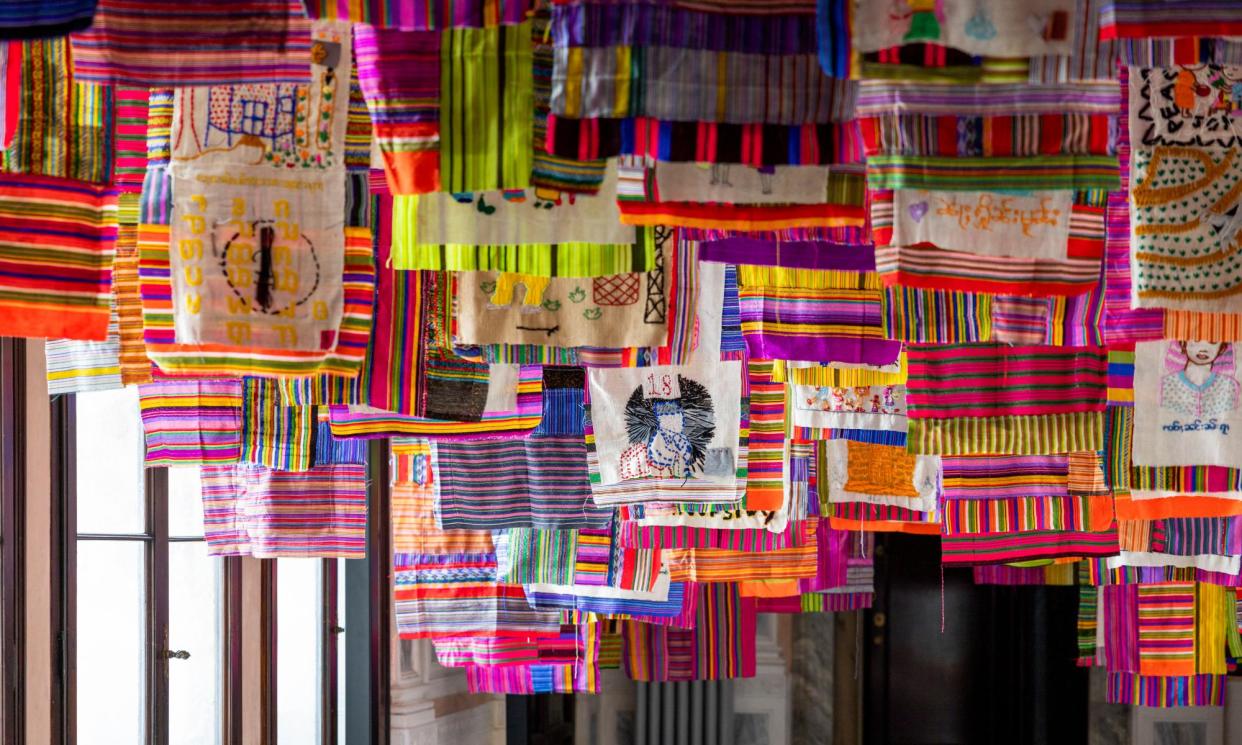Being seen and heard: Thai artist gives voice to Myanmar’s Shan refugees at biennales

The Koung Jor refugee camp on the Thai-Myanmar border is just three and half hours from Jakkai Siributr’s home in Chiang Mai. But it was only during a visit in 2019 that the Thai textile artist learned about the ordeals of the Shan refugees living there.
That visit inspired a collaborative embroidery project, with participation from 20 girls and women from the Shan ethnic minority living in the camp in northern Thailand, who were invited to sew images and words of their choice.
My works are about bringing unheard voices to the forefront, or issues that are not often spoken about
Jakkai Siributr
The result is a combination of intricately stitched, colourful pieces of fabric often featuring cartoonish images that are put together by Siributr in an installation entitled There’s No Place, which is on show at the Venice Biennale.
“I had no idea that these Shan refugees existed,” Siributr says. “The Koung Jor village is considered a refugee camp and happens to be on the temple grounds. It is on the Thai side of the border, and the border itself is just steps away, so people can still travel in and out.”
Koung Jor (“Happy Hill”) has more than 400 inhabitants and is one of six camps on the Thai-Myanmar border, altogether hosting more than 6,000 Shan people, which were set up in 2002 after violence in Myanmar’s Shan state forced people to flee. Thailand, which is not a signatory to the 1951 UN refugee convention, does not recognise them as asylum seekers, so most of them are stateless.
Siributr’s installation at Palazzo Smith Mangilli Valmarana in Venice is part of The Spirits of Maritime Crossing – an exhibition of south-east Asian art exploring themes of diaspora and displacement and presented by the Bangkok Art Biennale Foundation. On until late November, the exhibition takes place ahead of the Bangkok biennale, which runs from October to February.
Siributr says unfinished embroidered patches from Koung Jor were taken to a 2020 exhibition in Singapore, where members of the public “filled in what was not finished, some adding images, some words”.
“The public were only allowed to use black, white and grey threads,” he says, “to emphasise the fact that these stateless communities face limitations on a daily basis.”
In Venice, the embroidered pieces of fabric that make up There’s No Place are suspended like clothes hung out to dry on a washing line. A close examination of one piece shows a soldier firing at a group of people, including children.
It is not the first time Siributr has used embroidery to highlight the plight of people displaced from Myanmar.
An earlier work, The Outlaw’s Flag, is a series of imaginary flags created in 2017 after Siributr visited the city of Sittwe in Myanmar’s Rakhine state, the scene of massacres of the Muslim Rohingya people.
“I created these imaginary flags of imaginary places that were probably where [the refugees] would want to go.”
Born in Bangkok in 1969, Siributr studied textile design in the US in the early 1990s and has used the medium ever since.
“I have always been loyal to [the textile medium] and it’s something that I’m most familiar with. To this day, I get categorised as a textile artist, which used to bother me when I was much younger, but now it doesn’t really bother me because that’s what it is.”
When he returned to Thailand in 1996, Siributr felt that there were “things that are a little bit wrong”, and started learning about events that he was “ignorant about”, such as the 2004 Takbai incident, when 78 Muslim protesters died of suffocation while being transported to a detention centre in southern Thailand.
Works by 15 south-east Asian artists are being shown in Venice, including Cambodia’s Khvay Samnang, Myanmar’s Moe Satt and Singapore’s Priyageetha Dia.
Related: ‘I have no idea how I’ll survive’: Myanmar villagers who fled airstrikes face food shortage
The exhibition’s curator, Apinan Poshyananda, says that although the overall theme of this year’s Venice Biennale is Foreigners Everywhere and Asian artists are selected in the main exhibition venue, “there are few living south-east Asian artists included”.
The Spirits of Maritime Crossing exhibition, he says, “fills the gap of missing foreigners who are nowhere visible”.
Siributr, who spends half his time in Chiang Mai and the other half in Bangkok, where his art studio and three assistants are based, says: “My works are about bringing unheard voices to the forefront, or issues that are not often spoken about.”

 Yahoo News
Yahoo News 
